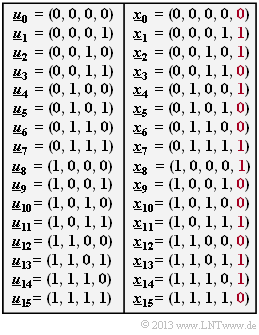Exercise 1.5: SPC (5, 4) and BEC Model
For this exercise it is required:
- The single parity-check code with parameters $k = 4$ and $n = 5$ ⇒ $\rm SPC \ (5, 4)$ adds to the information bits $u_{1}$, ... , $u_{4}$ a check bit $p$ so that an even number of ones occurs in each code word $\underline{x}$ :
- $$x_1 \oplus x_2 \oplus x_3 \oplus x_4 \oplus x_5 = 0 \hspace{0.05cm},$$
- $$ u_1 \oplus u_2 \oplus u_3 \oplus u_4 \oplus p = 0 \hspace{0.05cm}.$$
- The Binary Erasure Channel $\rm (BEC)$ - with binary input values $x_{i} \in \{0, \ 1\}$ and ternary output $y_{i} \in \{0,\ 1,\ \rm E\}$ leads with probability $\lambda = 0.1$ to an erasure $\rm E$.
- Furthermore, ${\rm Pr}(y_{i} = x_{i}) = 1 - \lambda = 0.9$ holds. A real transmission error is excluded:
- $$ {\rm Pr} \big[(x_i = 0)\cap (y_i = 1)\big] = {\rm Pr} \big[(x_i = 1)\cap (y_i = 0)\big] = 0\hspace{0.05cm}.$$
The relationship between the information word $\underline{u}$ and the code word $\underline{x}$ is given by the table. From the receive word $\underline{y}$ the vector $\underline{v}$ of information bits at the sink is formed by maximum likelihood decision, which should match the information word $\underline{u}$ as much as possible.
The following nomenclature applies:
- $$\underline{u} \ \in \ \{\underline{u}_0,\ \underline{u}_1,\hspace{0.15cm} \text{...} \hspace{0.2cm},\ \underline{u}_{15}\} \hspace{0.05cm},$$
- $$ \underline{v} \ \in \ \{\underline{v}_0,\ \underline{v}_1, \hspace{0.15cm}\text{...} \hspace{0.2cm},\ \underline{v}_{15},\ \underline{\rm E}\} \hspace{0.05cm}.$$
The result $\underline{v} =\underline{\rm E} = {\rm (E,\ E,\ E,\ E)}$ indicates that decoding of the code word is not possible due to too many erasures.
Hints:
- This exercise belongs to the chapter "Examples of binary block codes".
- Reference is also made to the chapter "Channel Models and Decision Structures".
- The check bits of $u_{0}$, $u_{4}$ and $u_{13}$ are to be determined in the subtask (1)'.
Questions
Solution
(1) The check bit $p$ is determined in the "single parity-check code" in such a way, that the sum of all ones in the code word $\underline{x} = (u_{1},\ u_{2}, ... ,\ u_{4},\ p)$ is even.
For example, one gets:
- $$\underline{u}_0 \hspace{-0.1cm}\ = \ \hspace{-0.1cm} (0, 0, 0, 0) \hspace{0.3cm} \Rightarrow \hspace{0.3cm} \underline{x}_0 = (0, 0, 0, 0, 0)\hspace{0.3cm} \Rightarrow \hspace{0.3cm} p \hspace{0.15cm} \underline{= 0} \hspace{0.05cm},$$
- $$ \underline{u}_4 \hspace{-0.1cm}\ = \ \hspace{-0.1cm} (0, 1, 0, 0) \hspace{0.3cm} \Rightarrow \hspace{0.3cm} \underline{x}_4 = (0, 1, 0, 0, 1)\hspace{0.3cm} \Rightarrow \hspace{0.3cm} p \hspace{0.15cm} \underline{= 1} \hspace{0.05cm},$$
- $$\underline{u}_{13} \hspace{-0.1cm}\ = \ \hspace{-0.1cm} (1, 1, 0, 1) \hspace{0.15cm} \Rightarrow \hspace{0.15cm} \underline{x}_{13} = (1, 1, 0, 1, 1)\hspace{0.3cm} \Rightarrow \hspace{0.3cm} p \hspace{0.15cm} \underline{= 1} \hspace{0.05cm}.$$
(2) Correct is answer 1:
- Because of the fact that the number of ones must be even, the erased check bit $p = 0$. Thus, $\underline{u}_{0}$ was sent.
(3) Correct is answer 2:
- According to the same considerations as in the last subtask, we arrive with $\underline{y} = (0,\ {\rm E},\ 0,\ 0,\ 1)$ to the result
- $$\underline{x} = \underline{x}_{4} = (0, 1, 0, 0, 1) ⇒ \underline{u}_{4} = (0, 1, 0, 0).$$
(4) The event $\underline{y} = \underline{x}$ occurs only if none of the $n = 5$ code bits is erased by the BEC channel:
- $${\rm Pr}(\underline{y} = \underline{x}) = (1 - \lambda)^5 = 0.9^5 \hspace{0.15cm} \underline{= 59.1\%} \hspace{0.05cm}.$$
(5) The event $v = u$ then occurs,
- if all code bits are transmitted correctly ⇒ ${\rm Pr}(\underline{y} = \underline{x})$,
- but also when only one code bit is erased. According to the binomial distribution, there are five possibilities for this:
- $${\rm Pr}(\underline{v} = \underline{u}) \hspace{-0.1cm}\ = \ \hspace{-0.1cm} {\rm Pr}(\underline{y} = \underline{x}) + 5 \cdot (1 - \lambda)^4 \cdot \lambda = 0.591 + 5 \cdot 0.656^4 \cdot 0.1 \hspace{0.15cm} \underline{= 91.9 \%} \hspace{0.05cm}.$$
(6) Due to the BEC model, the falsification of a code word $\underline{x}$ is per se impossible, since none of the bits can be falsified from $0 → 1$ or from $1 → 0$. Rather:
- $${\rm Pr}(\underline{v} = \underline{u}) + {\rm Pr}(\underline{v} = {\rm\underline{ E}}) = 1 \hspace{0.3cm} \Rightarrow \hspace{0.3cm} {\rm Pr}(\underline{v} = {\rm\underline{ E}}) = 1 - {\rm Pr}(\underline{v} = \underline{u}) \hspace{0.15cm} \underline{= 8.1\%} \hspace{0.05cm}.$$
